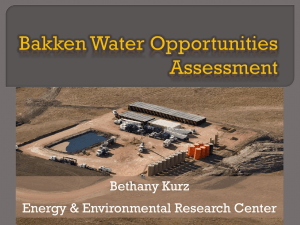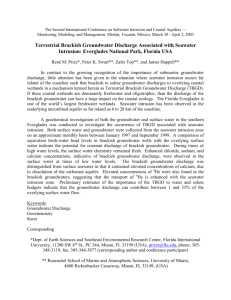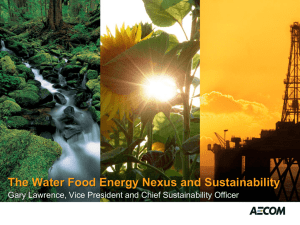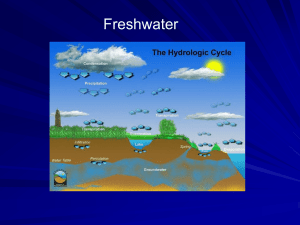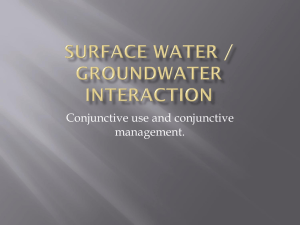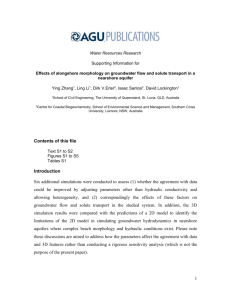1. Freshwater, Marine and Brackish Water Resources
advertisement
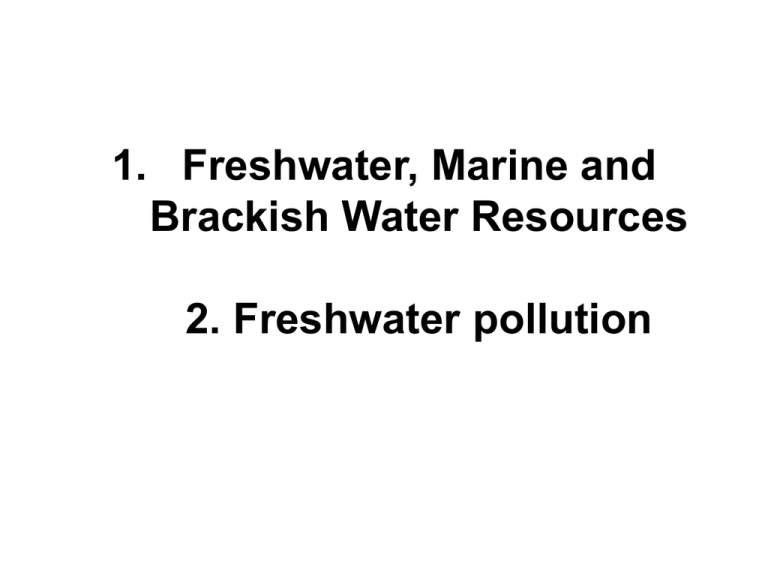
1. Freshwater, Marine and Brackish Water Resources 2. Freshwater pollution Learning Outcomes • At the end of this section, the students will be able to – describe difference between different types of water resources – Identify different sources of freshwater pollution Water class Electrical conductivity dS/m Salt Type of water concentration mg/l Non-saline <0.7 <500 Drinking and irrigation water 500-1500 Irrigation water Slightly saline 0.7 - 2 Moderately saline 2 – 10 1500-7000 Primary drainage water and groundwater Highly saline 10-25 7000-15 000 Secondary drainage water and groundwater Very highly saline 25 – 45 15000-35000 Very saline groundwater Brine >45 >45 000 Seawater • Freshwater – bodies of water such as ponds, lakes, rivers and streams containing low concentrations of dissolved salts and other total dissolved solids. In other words, the term excludes seawater and brackish water. – an important renewable resource – lakes and ponds, rivers, underground water and man-made freshwater bodies, such as canals, ditches and reservoirs. • Freshwater is defined – water with < 0.5 ppt dissolved salts • Water salinity based on dissolved salts in parts per thousand (ppt) – Freshwater < 0.5 – Brackish water 0.5 – 35 – Saline water 35 – 50 – Brine > 50 • Groundwater – water located beneath the ground surface in soil pore spaces and in aquifers • Aquifer – a layer of relatively porous substrate that contains and transmits groundwater – Unconfined Aquifer - water can flow directly between the surface and the saturated zone – upper level of saturated layer of an unconfined aquifer is - water table – Confined aquifer - aquifer overlain by a relatively impermeable layer of rock or substrate Problems faced by groundwater utilization • Overdraft – lowering of water table beyond the reach of existing wells – extraction of groundwater linked to a river system affects river flows • Subsidence – hydraulic pressure of groundwater and aquitard (substrate with relatively low porosity that permits limited transmission of groundwater) supports some of weight of overlying sediments – by excessive pumping, pore pressures in the aquifer drop and compression of the aquifer causing land subsidence, a drop in the ground surface – New Orleans, San Jose, Bangkok • Seawater intrusion – recharge zone of an aquifer near the seacoast is likely to be inland – a lowered water table may induce sea water to reverse the flow toward the sea – Sea water moving inland is saltwater intrusion • Flood mitigation, infrastructure built on floodplains – reduced aquifer recharge Brackish water • result from mixing of seawater with fresh water, as in estuaries, or it may occur in brackish fossil aquifers • Brackish water habitats – Estuaries, mangroves, brackish seas and lakes – Uses – Desalination for drinking – Aquaculture – In irrigation – moderately salt tolerant/tolerant crops – Industrial – cooling Saline water – three categories • Slightly saline water - 1,000 to 3,000 ppm • Moderately saline water - 3,000 to 10,000 ppm • Highly saline water - 10,000 to 35,000 ppm of salt – Seawater - roughly 35,000 ppm (= 35 g/L) Causes of Saline water • Water in rock formations that occurred in marine conditions • Weathering of salts from rock strata with naturally high salt content leads to salts moving into aquifers • Discharge of irrigation return flows • accelerated groundwater seepage to surface systems • discharges of domestic and industrial wastewater • intrusion of seawater into coastal aquifers • Over extraction of the freshwater • Use of Saline water – desalination for drinking – heated wastewater in the cooling process and brine disposal issues – agriculture – crop production, aquaculture, forage production, – in thermoelectric-power industry to cool electricitygenerating equipment – mining and other industrial purposes – used extensively to irrigate gardens, parks and sports fields – biomass production – salt extraction • Water Pollution – contamination of water bodies such as lakes, rivers, oceans, and groundwater – impaired by anthropogenic contaminants and either does not support a human use (like serving as drinking water, irrigation water etc.) or limits the support of biotic communities • Primary sources of water pollution grouped into two – Point-source pollution • refers to contaminants that enter a waterway through a discrete "point source“ i.e. discharges from a wastewater treatment plant, outfalls from a factory, leaking underground tanks, etc. – Non-point source pollution • contamination that does not originate from a single discrete source • cumulative effect of small amounts of contaminants gathered from a large area i.e nutrient runoff in storm water from sheet flow over an agricultural field



